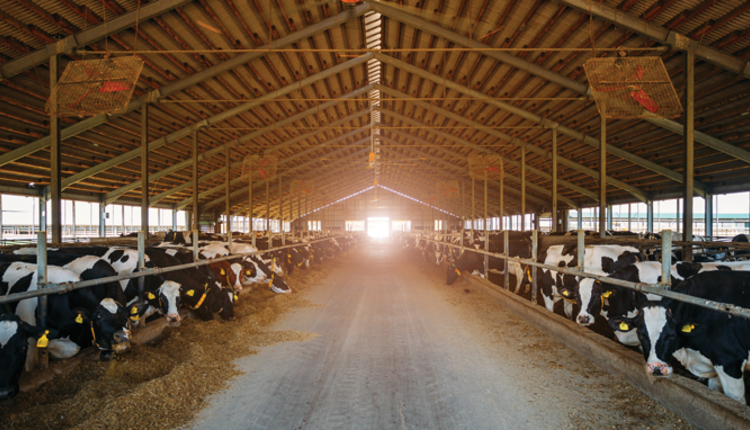The author is a dairy and agricultural writer based in Columbus, Ohio.

In recent years, dairy cow populations have shifted, with more cows in the Northern and Southern Plains and fewer in the Northeast and Southeast. Processing plants are also being built or expanded, primarily in areas with growing cow numbers and, in recent years, plenty of access to water. In a “chicken or egg” paradox, which comes first? Do cows move and plants follow, or vice versa?
“Historically, milk sheds have been built with the dairy producer going first,” said Bill Curley, vice president and chief economist for Ever.Ag. “Dairy producers find a low-cost place to milk cows, and then processors put in a plant because there is access to cheap milk. As the market improves, other producers build new dairies, feeding expansion and growth of the milk shed.”
This explains the growth of the milk sheds that now exist in Idaho, New Mexico, and Texas. Three decades ago, dairy farmers in the three states milked a combined 719,000 dairy cows, fewer than were milked in New York alone. The environment was attractive for milking cows, so dairy producers flocked, and processors followed. Today, the three states are home to nearly 1.6 million dairy cows.
There are slight, sure signs that cow populations are shifting once again. Processors are now investing tremendous amounts of capital to more efficiently process current milk production along with anticipated growth. But where are they doing this? Are they following the cows?
There has also been a recent shift in the dynamics that initiate decisions to build and expand processing facilities. “The current wave of plant investment looks somewhat different in that most or all of the plant growth has been linked to milk growth,” said Mike McCully, owner of McCully Consulting. “Processors contracted with producers before they built plants, so producers knew they had a home for their milk, and processors knew they would get the milk they needed.”
In this era of high risk, growth has been symbiotic.
By the numbers
Generally, cows are moving inland, solidifying a trend that began years ago. Over the past five decades, at least 85% of the cow population once milked in West Virginia, Kentucky, Tennessee, South Carolina, Alabama, Arkansas, Louisiana, and Mississippi have disappeared. Just two states south of the Mason-Dixon Line — Florida and Georgia —have maintained herds of significance, with populations of just over 90,000 cows each. Much of New England and the Mid-Atlantic has not fared better. Except for New York, Pennsylvania, and Vermont, cow populations in all these states are half of what they were 50 years ago or less.
On the flip side, major growth has come to the heart of the country. Over the past decade, cow numbers have risen in a dozen states. Double-digit gains have occurred in Colorado, Georgia, Idaho, Iowa, Kansas, Michigan, Nevada, South Dakota, and Texas. In South Dakota, the cow population has more than doubled, and in Colorado and Texas it is 50% greater.
In the grand scheme, though, the losses and gains outside Texas and Idaho are based on relatively small cow populations. The states that produce the lion’s share of milk in this country have remained largely unchanged. Fifty years ago, Wisconsin was the nation’s leading milk producer, with nearly twice as much milk as any other state. The nine other top producers, in descending rank, were California, New York, Minnesota, Pennsylvania, Michigan, Ohio, Iowa, Texas, and Missouri. Today, Ohio, Iowa, and Missouri have dropped from the top 10, replaced by Idaho, New Mexico, and Washington.
Of perhaps greater significance is the character of the herds that are doing the moving. “There is a shift in the way milk is being made,” said Curley. “It is being produced by fewer, but much larger, family-owned dairies, many with herds in multiple states.”
McCully echoed these sentiments. “This is in keeping with the consolidation that is happening at both the farm and processor levels. There will still be a place for smaller farms, but mid-sized farms and plants will find it hard to compete.”
One cannot underestimate what this means. Using 2023 U.S. Department of Agriculture statistics, each of the 100 herds in New Mexico, with an average herd size of 2,710 cows, produces 66.6 million pounds of milk on average per year. In Texas, with an average herd size of 2,071 cows, per farm production stands at 53.4 million pounds of milk. In Colorado, the average herd size is 1,827 cows, and per farm annual production is 47.4 million pounds of milk. In Idaho, the 390 herds with 1,710 cows on average produce 43.1 million pounds of milk per herd per year. As a comparison, the average American dairy farm milks 357 cows and produces 8.6 million pounds of milk per year.
What about climate change?
While there are large cow populations in the West and Southwest today, the writing may be on the wall for change. An abstract published in the Journal of Dairy Science in February 2018 notes that nearly half of domestic milk production originates in states that are expected to have severe water shortages in 40 years. The authors predict a significant portion of dairy cows in these areas will be relocated, with North American dairy expansion most suitable in the Upper Midwest and Great Lakes regions and the central provinces of Canada, which are forecast to have adequate water resources and longer growing seasons.
Dairy economists, including McCully, agree. “My overall view is that milk production is migrating to areas of lower production costs, with available water and feed, among other factors,” he said.
Curley put it this way. “Dairy producers do the math to determine the ‘best’ place to expand. There are lots of reasons why the best is the best,” he noted. “Typically, there is access to a milk market, feed, and cheap land and construction costs. There is the ability to control the environment in which cows are managed and efficiently make cheap milk.
“The ‘best’ place is where all the cows wind up,” he summarized. “Over the years, the hot place to milk cows has changed. A variety of factors today limit where dairy producers can expand.
“Places like the I-29 corridor are among the last frontiers for milking cows because they check all the boxes,” remarked Curley.
The “dairy friendliness” of a region also impacts expansion decisions.
“Right now, some places are dairy friendly, some are not,” commented Corey Geiger, the lead dairy economist at CoBank. “Though ‘dairy friendly’ can mean many things, it is crystal clear California is a challenge for production agriculture with more regulations than nearly any other state. Washington isn’t far behind with its regulations and nutrient management requirements.
“Conversely, South Dakota and Idaho have taken an open-arms approach to dairy, and Wisconsin realizes dairy is a major driver for its economy,” he continued.
Investment is confidence
An investment in a new processing plant, much like that for a new dairy farm, is substantial and takes years to recover. With the U.S. seen as having the best prospects for making new milk among the world’s largest three dairy exporters, processors have invested an unprecedented $7 billion to expand or build plants that will be online by 2026. Largely, growth is in the central part of the country and pockets in the East near major urban populations.
“Outside the new Darigold milk powder and butter plant in Pasco, Wash., and the new California Dairies Inc. aseptic plant in Bakersfield, there is minimal processing growth in the western third of the country. Cheese growth in the central part of the country will primarily supply the domestic market,” McCully said.
With cheese driving dairy consumption here and abroad and extended shelf life and aseptic milk offering new opportunities, processors are investing big dollars to meet demand. Consider the following examples:
- In Wisconsin, Agropur doubled the production capacity of its Little Chute plant with a $168 million investment, and Grande Cheese broke ground on an expansion that will quadruple production capacity at the Chilton plant it purchased from Foremost Farms.
- Bongards is expanding its Perham plant in Minnesota by 30% with a $125 million investment and a completion date of June 2025.
- Valley Queen is investing $195 million to expand the capacity of its Millbank, S.D., plant by 50% come January 2025.
- Hilmar Cheese is building a second facility outside its California headquarters, this time in Dodge City, Kan., with a capacity of 260 tanker trucks a day.
- Cacique Foods opened the doors to its new facility in Amarillo, Texas, in May 2023.
- Also in Texas, Leprino Foods is building a $1 billion plant in East Lubbock that should be shipping products this fall.
- Walmart is building a pair of $350 million plants in Georgia and Texas.
- In the Empire State, fairlife is constructing a $650 million plant near Rochester and Great Lakes Cheese is building a new cheese plant with a $518 million capital investment in Franklinville. Upstate Niagara Cooperative Inc. announced it is doubling its plant in West Seneca with a $150 million investment.
“The rise of farmer-owned processing plants is a trend that will likely continue as farms get larger,” McCully remarked. “Large producers and groups of producers are increasingly investing in milk processing to forward integrate into the dairy value chain. Examples of this are farmer-owned Cayuga Milk Ingredients, which is investing $150 million to build a new aseptic bottling facility, and Panhandle Products LLC, established by farmers three years ago and on track to process cheese and whey powder this fall.”
Hand in hand
We all know the chicken and egg paradox cannot be answered. The same could be said for dairy producers and their cows and dairy processors. They go hand in hand.
“We are living in a time when the producer-processor relationship requires more synergy than ever,” Geiger noted. “If history teaches us anything, it’s that positive synergy — the act of working together — has been key to some of our country’s greatest dairy success stories.”
A trusting, transparent producer-processor relationship is worth its weight in gold. Supply chain vulnerabilities exposed by the pandemic, like dumped milk and unraveled milk markets, illustrated the significance of this relationship.
If you are a producer considering a change of zip code or planning to expand, a two-way conversation with your processor is one of the first steps to take.
Whether cow movements in the past few years evolve into a long-term trend or turn out to be a passing fad will only be revealed with time. Given the weight of the factors driving the shift, most would wager on long-term change.





